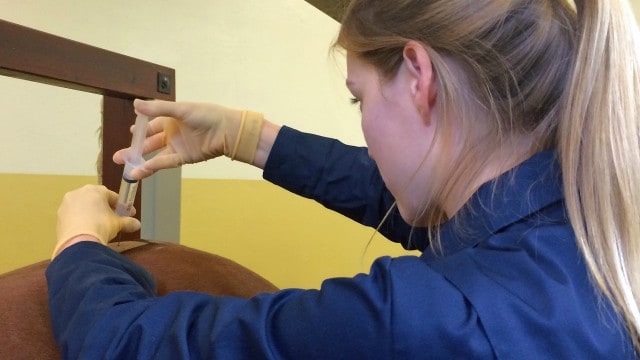Diary of an equine vet: Time to reflect

Laura Jones BVSc MRCVS is a Junior Clinician at the Animal Health Trust (AHT) Equine Clinic in Newmarket. In this regular diary series she will share her insights about her job as an equine vet.
“With autumn here the influx of cases that we see during the summer calms down (marginally!) so now is the time when one can breathe enough to reflect on what has passed. In the months I have been here at the AHT there have been hundreds of cases referred to us for specialist opinion. Some are referred specifically for advanced imaging but many come for full evaluation. Although we are a specialised equine clinic there is no end of variety in the work which is one of the things I love about the AHT. We see everything from very subtle lameness causing poor performance to multilimb lameness that can cause a huge amount of difficulty when ridden – and some very unusual cases too.
Over the last several weeks of working alongside one of the senior clinicians Dr Rachel Murray I have noticed a common theme emerging in almost all of the recent cases we have seen together: sacroiliac joint region pain. Although a similar diagnosis was made for these horses the clinical signs shown by each were very different.
For example one horse tended to move with the hindlimbs abnormally wide apart (I’ve never seen a horse move quite like it!) was very stiff through the back at both trot and canter when ridden and was reluctant to perform transitions into canter frequently breaking back into trot. The owner of this horse reported that on occasions it was impossible to get the horse to canter at all and sometimes even getting the horse to trot could be a difficult task.
Another had a very poor quality canter but this was only appreciated when ridden; when lunged in canter the horse appeared quite happy. A more severely affected case bucked and kicked out almost continually on the lunge and even when walked and trotted in hand the horse would kick out in pain. Once other causes of hindlimb lameness had been ruled out in these cases injecting local anaesthetic (numbing) solution into the region of the left and right sacroiliac joints of these horses resolved these issues and they were each transformed in their way of going.
Seeing the horses work willingly and happily after the injection highlights how dramatically sacroiliac joint region pain can affect their performance and welfare. Unfortunately there is no easy way of fixing horses with pain in this area and treatment can be frustrating. Sacroiliac joint region pain is not a single condition per se and definitive (specific) diagnosis is difficult hence why it is correct to call it sacroiliac joint region pain. The local anaesthetic solution does not solely affect the sacroiliac joints but can also affect other nearby joints and soft tissues – eg ligaments and nerves. The deep position of the region limits our imaging capabilities so an absolutely definitive diagnosis for the precise structure(s) causing pain cannot always be reached. Therefore specific targeted treatments cannot always be performed and we aim to provide pain relief and attempt rehabilitation to provide improved muscular support.
In a fast-paced job it is easy to stay in the moment constantly working forward. However even looking back through the small number of cases I’ve worked with only recently proves to me how important it is to always be thinking as a lot of important information can be gained. This handful of cases highlights several things to me: firstly the huge variation in clinical signs between horses and the importance of diagnostic analgesia (blocking) in diagnosis of sacroiliac region pain. Secondly the huge impact that suffering with this condition has on horses and with the poor prognosis for chronic cases the importance of a timely diagnosis.
Although we are constantly pushing the boundaries of our knowledge there is still so much for us to learn even about conditions we see relatively frequently. And with that reminder about the importance of clinical research I had better get back to mine (data collected for 570 horses and counting… phew!)”
Laura






